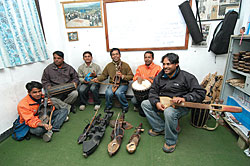|
|
When you bump into the many street musicians wandering the lanes of Thamel with their sarangis, you would hardly believe they are the descendants of Nepal's wandering minstrels with their epic songs.
These are the Gandharbas, one of the 23 dalit castes who until a few decades ago would roam from village to village taking their story-songs with them. Music was their only occupation, and despite the stigma attached to their caste, they would attract crowds keen to listen to their songs or to learn of news from distant parts of the land. In return, the entertainers received food or a few rupees.
Inevitably their role in society waned with the advent of other forms of musical entertainment, and the Gandharbas know all too well that in the age of satellite tv and FM radio they must reinvent themselves.
Many, especially the younger ones, have already moved to Kathmandu, where they make and sell the four-stringed sarangis which used to earn a living for their ancestors. They have also begun to record their own CDs for sale, and teach Nepalis and curious foreigners how to play the instrument. To fight for survival in the increasingly competitive world of Thamel, they set up the Gandharba Cultural and Art Organisation in 1994.
|
|
An estimated two out of three Gandharbas are illiterate, something the organisation's secretary, Kedar Gandhari, is keen to change. "I am not afraid that once educated they will turn their back on our traditions," he says. "In fact, those of us who manage to get a proper education will research our culture and history and maybe write a book about us."
According to the 2001 national census, there are just 4,500 Gandharbas, representing just 0.03 per cent of Nepal's population, such a tiny proportion of the country's total that they might never get proper parliamentary representation.
The cultural centre has many ideas for improving its community's lives. Top priority is an empowerment project to make villagers aware of their rights.
"The Gandharbas in the districts know nothing of the political developments in the country," says Gandhari. "They don't have any social awareness and are not interested in politics. A big revolution has taken place in Nepal, but if we don't learn about politics, we will always be lagging behind."
Despite the fierce competition for customers on the streets of Thamel, the most active members of the centre do not let themselves be put off.
|
|
Stephanie Spray, one of several foreign researchers involved in studying and promoting Gandharba culture, says that many Nepalis are aware they are the members of a unique caste with a complex and rich history.
"Unfortunately, cultural capital does not necessarily translate into forms of economic or social benefit: often they must hustle for support and attention," says Spray, who is researching a PhD on the Gandharbas at Harvard University.
But she says poor management and internal feuds within the organisation sometimes reduce the benefits the Gandharba community could gain from outside support. Despite such shortcomings, Spray says the cultural centre remains a very important base in the city for Gandharba men and their families when they are away from their villages.
Himalayan bluegrass
"The first time I heard a sarangi being played, I immediately noticed the similarities to Appalachian music," says Jacob Penchansky, a "guerrilla ethnomusicologist" from the US, who has been working on an ambitious musical project with the Gandharbas. Penchansky says the melodic scales and rhythms on the fiddle and sarangi are very similar, and the lyrics touch on the same aspects of peasants' everyday life: "No matter what country you're in, people like to share the same kinds of stories when they're done working in the fields."
Along with Tara Linhardt and Danny Knicely, two established bluegrass musicians who share his love for Nepal, Jacob launched the Mountain Music Project in 2006. A 10-man crew from the US travelled for three weeks to Gorkha, Lamjung, Pokhara, Palpa and the tarai, filming, recording and interviewing the Gandharba musicians they met along the way.
"We were especially looking for old songs that might not be passed down to the next generation, and for any Gandharbas who still went village to village as wandering minstrels," says Penchansky.
But rather than confining their work to simply recording old Gandharba music, the group also spent time teaching local people Appalachian songs and being taught their own, and finally recording the jamming sessions. The group's labour of love is a CD, to be released in 2008, tentatively titled "Old-Time Himalayan Bluegrass". The recording will include six Nepali and six Appalachian songs and feature musicians from both the US and Nepal.
"Travelling around the countryside, meeting and jamming with local musicians, sharing our music and learning about Nepali musical heritage firsthand... it was an absolute blast," says Penchansky, who is hoping to release the CD in Nepal too.
An in-depth account of the group's adventures as well as audio and sound bites can be found at www.mountainmusicproject.blogspot.com





